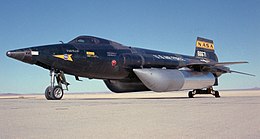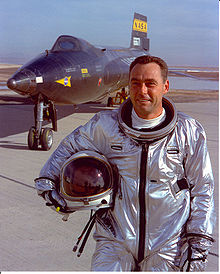X-15 Flight 188
 North American X-15A-2 with external tanks, before heat shield paint | |
| Mission type | Test flight, Record speed test |
|---|---|
| Operator | USAF/NASA |
| Range | 342.79 (213 miles) |
| Apogee | 58.4 kilometers (36.3 mi) |
| Spacecraft properties | |
| Spacecraft | X-15-A2 |
| Manufacturer | North American |
| Crew | |
| Crew size | 1 |
| Members | William J. Knight |
| Start of mission | |
| Launch date | October 3, 1967 UTC |
| End of mission | |
| Landing date | October 3, 1967 UTC |
| Landing site | Rogers Dry Lake, Edwards |
 William J. Knight with an X-15 | |



The North American X-15's Flight 188 on October 3, 1967, was a record-setting flight. William J. Knight took the X-15A-2 hypersonic rocket-powered aircraft to 102,100 feet (31,100 meters) over Mud Lake, Nevada when Flight 188 reached a record-setting top speed of 4,520 mph (7,270 km/h), Mach 6.70.[1]
History[edit]
Flight 188 used North American Aviation X-15 Number 2 aircraft, number 56-6671, 2A-F12. The X-15, model X-15A-2 had many modifications from the original X-15A. The X-15 number 2 on, flight 74, was damaged during landing on November 9, 1962, and was repaired and updated to become the X-15A-2. The X-15A-2 fuselage was lengthened 28 inches (0.71 meters). This new space was designed for a liquid hydrogen fuel tank. The liquid hydrogen was to feed a scramjet engine that was flown but not used. The dummy scramjet was mounted on the ventral fin of the X-15A-2. Two external drop tanks were added to increase fuel by 75%. The tanks held liquid ammonia and liquid oxygen. The external tanks provided 60 seconds of additional engine burn. The added tanks added 57,000 pounds (26,000 kg) to the X-15. The internal and external tanks held about 7 tons of fuel. To handle the heat of atmospheric entry, the entire surface of the X-15A-2 was covered in Martin MA-25S ablative heat shield. The ablative heat shield was designed to char and slowly break away, carrying away heat in the process. The Martin MA-25S was pink in color, then a white top coat sealer was applied on top of the Martin MA-25S. After the flight, it was found that the craft had heat damage that was not economical to repair after some repairs were completed. During landing, the scramjet broke off due to heat damage. Flight 188 landed on Rogers Dry Lake in California after a flight time of 8 minutes and 17.0 seconds.[2]
Flight 188 was the 53rd flight for X-15 Number 2 and the 5th flight as the modified X-15A-2. The X-15A-2 used a reaction Motors XLR99 engine by the Reaction Motors Division of Thiokol Chemical Company. William J. Knight was a test pilot for the United States Air Force and NASA. The X-15A-2 Number 2 was the only X-15 to have the external tank modifications. Because of heat damage, the scramjet broke loose and fell away from the X-15A-2. The dummy scramjet was fitted for speed testing, the goal was to have real flight test and compare this with the wind tunnel testing. The extreme heat at scramjet, over 2,700 °F (1,480 °C), burned a hole into the scramjet and then the top ventral fin. Due to the damage, limited test data was collected. The scramjet was found on Edwards Air Force Base's bombing range. The breakaway did not affect the landing of the X-15A-2. During the landing at Mach 5.5 the X-15A-2 gave an over-temperature warning in the XLR-99 engine bay. For fire safety and to lighten the X-15A-2, Knight tried to jettison remain fuel in the internal fuel tank. But, the heat had damaged the fuel jettison system. The X-15A-2 was able to jettisonable lower fin, needed for landing. Knight was able to land the heavier than normal X-15A-2 at a faster than normal speed safely. At Edwards Air Force Base two radio relay stations and six emergency landing strips were built on the dry lake beds. Touchdown was at 14:40:07 local time at Edwards Air Force Base after 342.79 (213 miles) of flight. Total engine burn time was 2 minutes and 20 seconds. North American F-100 Super Sabre, Lockheed F-104 Starfighter and Douglas F5D Skylancer jets were used as chase planes, that tailed the X-15A-2 as long as it could at launch and also as the X-15A-2 landed. The F-100 Super Sabre and F5D had a top speed of Mach 1.4. The F-104 had a top speed of Mach 2.
Flight 188's take-off was delayed by some minor problems that were fixed. A modified Boeing B-52 Stratofortress, model NB-52B, was used to take the X-15A-2 to height. The NB-52B, NASA Balls 8, carried the X-15A-2 under the right wing. Balls 8 released the X-15A-2 at a speed of 500 miles per hour (805 km/h) (Mach 0.82) and an altitude of 45,000 feet 8.5 miles (13.7 km) at 14:31:50.9 local time.[3] Balls 8 carried 106 of the 199 X-15 program flights. The external tanks were jettisoned 67.4 seconds after launch at a speed of Mach 2.0 and 70,000 feet. The total engine burn time during the flight was 141.4 seconds. After Flight 188, 11 other X-15s would fly before the program was retired. The X-15 program data was used in the planning of future aircraft and spacecraft designs.
Flight 188 held the crewed winged spaceplane speed record till it was passed by STS-1 of the Space Shuttle Columbia on April 14, 1981. Flight 188 is still a speed record for a non-orbital aircraft in the atmosphere under a powered manned flight. Knight was awarded the Harmon International Aviation Trophy in 1969 for his record setting flight by President Lyndon Johnson. Knight would fly three more X-15s, Flights: 194, 196 and 198.[4]
X-15A-2 Number 2 aircraft was taken to the National Museum of the United States Air Force in Dayton, Ohio[2] and repainted for permanent display.[5][6][7]
Flight 188 flight log[edit]
- X-15A-2, modified X-15 with external tanks and ablative coating
- Gross mass: 16,069 kg (35,426 lb)
- Unfuelled mass: 7,766 kg (17,121 lb)
- Specific impulse: 276
- Craft length: 15.97 m (52.4 ft)
- Craft Height: 15.47 m (50.8 ft)
- Craft Diameter: 1.42 m (4.7 ft)
- Wing Span: 6.80 m (22.3 ft)
- Reaction Motors XLR99-RM-2 engine, Burn time: 90 seconds on internal fuel
- Thrust: 262.445 kN (59,000 lbf)
- Engine: about 600,000-horsepower
- Fuel: liquid-fuelled: liquid oxygen and anhydrous ammonia
- Total fuel: 8,303 kg (18,305 lb)
- Max speed Mach 6.70, a speed record
- External tank: Gross Mass: 7,026 kg (15,490 lb)
- External tank: Empty Mass: 902 kg (1,989 lb)
- External tank: Diameter: 0.98 m (3.2 ft)
- External tank: Span: 0.98 m (3.2 ft)
- External tank: Length: 6.86 m (22.5 ft)
- External tanks: Burn time 60 seconds, External fuel
- External tanks: 6,814 liters (1,800 U.S. gal)
- Flight length: 342.79 km (213.00 mi)
- Glide time: 6 min., 10 seconds
- Peak surface temperature: over 649 °C (1,200 °F)
- XMC-2 pressure suit
X-15A-2 Number 2 flights with external tanks[edit]
- Flight 155 – November 3, 1965, with empty external tanks, pilot Robert A. Rushworth, Mach 2.31, 5 minutes, 2 seconds[8][9]
- Flight 159 – July 1, 1966, pilot Rushworth (last flight), Mach 1.70, 4 minutes, 29 seconds[10]
- Flight 175 – November 18, 1966, pilot Knight, Mach 6.33, 8 minutes, 27 seconds, second fastest flight[11]
- Flight 186 – August 21, 1967, with full ablative coating. pilot Knight, Mach 4.94, 7 minutes, 39 seconds[12]
- Flight 188 – October 3, 1967, with dummy Ram-Jet and ablative coating, pilot Knight, Mach 6.70, 8 minutes, 12 seconds[2]
See also[edit]
References[edit]
- ^ Swopes, Bryan (2016). "Flight 188". This Day in Aviation.
- ^ a b c Thompson 1992, p. 350.
- ^ "X-15 launch from B-52 mothership". Dryden Flight Research Center. February 6, 2002. Photo E-4942.
- ^ "William Joseph Knight Biography". worldspaceflight.com. August 20, 2017.
- ^ "X-15 – Hypersonic Research at the Edge of Space". NASA. Retrieved January 1, 2015.
- ^ Wade, Mark. "X-15A-2". Encyclopedia Astronautica. Retrieved April 3, 2023.
- ^ Krebs, Gunter D. "X-15A-2 with external tanks". Gunter's Space Page. Retrieved April 3, 2023.
- ^ X15 Fightsworldspaceflight.com
- ^ Thompson 1992, p. 335.
- ^ Thompson 1992, p. 337.
- ^ Thompson 1992, p. 344.
- ^ Thompson 1992, p. 349.
Bibliography[edit]
- Thompson, Milton O. (1992). At the Edge of Space: The X-15 Flight Program. Washington: Smithsonian Institution Press. ISBN 1-56098-107-5. OCLC 24010699.
External links[edit]
- Footage of X-15A-2 Flight, POV & from B-52 & Chase Plane on YouTube
- Reaction Motors XLR99 Rocket – National Museum of the United States Air Force
- XLR-99
- NASA
- X-15: Hypersonic Research at the Edge of Space
- Hypersonics Before the Shuttle: A Concise History of the X-15 Research Airplane
- The short film Research Project X-15 is available for free viewing and download at the Internet Archive.
- Non-NASA
- X-15A at Encyclopedia Astronautica
- X-15: Advanced Research Airplane, design summary by North America Aviation


